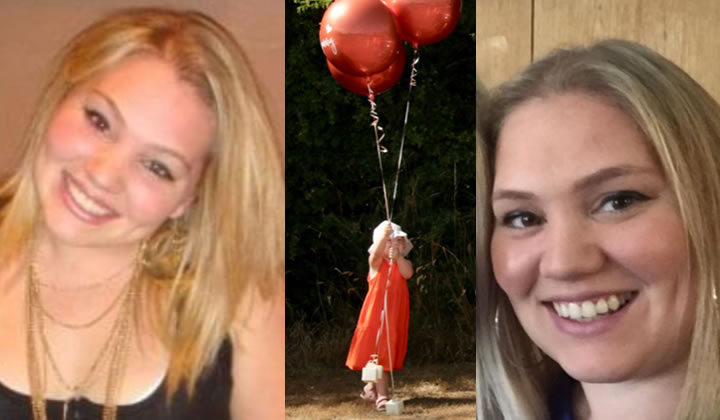
Samantha’s death was avoidable and her mother, Jane, wants to tell Samantha’s story to make women aware of the risk of thrombosis during and after pregnancy.

Samantha’s death was avoidable and her mother, Jane, wants to tell Samantha’s story to make women aware of the risk of thrombosis during and after pregnancy.
Samantha was a healthy 32 year old woman when she became pregnant with her third child. However, although she was healthy at the start of her pregnancy, there were risk factors that were not identified during her pre-natal and post-natal care. Samantha died from a pulmonary embolism on 16 March 2020, five weeks after the birth of her baby. She left two other children aged 9 and 5 and a family devastated by her death.
Samantha’s death was avoidable and as her mother, I want to tell her story to make women aware of the risk of thrombosis during and after pregnancy.
In her first three months of pregnancy, Samantha suffered from severe morning sickness which extended through the day and made it difficult for her to leave the house. As soon as the morning sickness improved, she started to suffer pelvic girdle pain. She had suffered from this late in her previous pregnancy but this time the pain started earlier in her pregnancy and was very debilitating. It became increasingly difficult for her to move.
Samantha had no idea this lack of movement might present a risk of thrombosis and the increased risk was not identified or explained to her by the health professionals she saw during her pregnancy.
The pelvic girdle pain ended when her baby was born and Samantha left the hospital with a beautiful baby daughter. However, she was still suffering discomfort as she had had to have stitches following the birth and again, it was difficult for her to move.
Five weeks after the baby was born, Samantha finally felt completely well and able to move around normally. Her life with three children was busy and she was enjoying introducing her new baby to friends and family.
On 15 March 2020, she went shopping in her local town with the baby and called me on her return from the shops. She was laughing about a wheel having fallen off her baby buggy during the trip when, suddenly, she stopped talking. There was no one else in her house at the time, apart from the baby. I was desperately shouting her name and then realised I needed to call 999.
The paramedics and air ambulance crews found her and worked tirelessly to resuscitate her. She was taken to the ICU at the local hospital where she passed away in the early hours of 16 March. She had a massive blood clot between her heart and lungs – a pulmonary embolism which can cause sudden, unexpected, death.
Samantha died just as the first Covid patient was being brought into the ICU. The pandemic lockdown meant we were unable to hold a funeral service and grieve for Samantha as we normally would.
An independent report commissioned by the midwives into Samantha’s death, to which I contributed, has not been published, due to the pressures of Covid and other circumstances. This is one reason I am so grateful to Thrombosis UK for the work this charity is doing to raise awareness.
On 16 July 2022, we held a Festival Day to celebrate Samantha’s life. It was a lovely occasion with music, face painting, balloons and bunting and lots of family and friends able to share their happy memories of someone very special. As well as being an amazing mother to her children, Sam was a gifted mental health nurse and some of her colleagues came along to tell us how good she was at her job and how much she is still missed.

It is difficult to watch my grandchildren grow up without their mother to care for them and witness their achievements, especially knowing Samantha’s death was avoidable.
I have been told that thrombosis and thromboembolism remain the leading cause of direct maternal death during or up to six weeks after the end of the pregnancy. I don’t want any families to have to suffer as we have, so please support the work of Thrombosis UK and bring the risk of thrombosis during and after pregnancy to the attention of others.